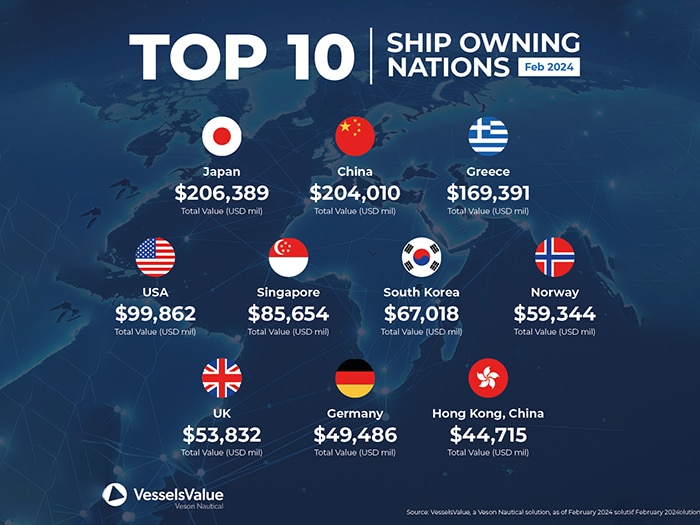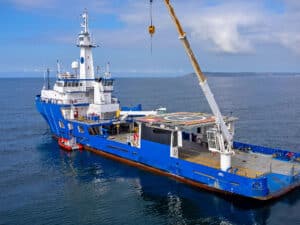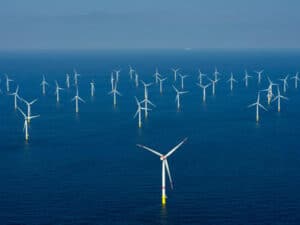
U.S. still world’s number 4 shipowning nation
Written by Nick Blenkey
Image: VesselsValue
VesselsValue has unveiled its list of this year’s top 10 shipowning nations, based on the total asset values of vessels and their country of beneficial ownership.
Rebecca Galanopoulos-Jones, senior content analyst, Veson Nautical (which acquired VesselsValue last year says that “from Japan’s resolute leadership in the top position with a USD 206.3 billion fleet to the emergence of Hong Kong at $44.7 billion, asset values and ownership strategies have changed considerably over the last 12 months.”
1: JAPAN
Japan continues to lead, taking number one spot among shipowning nations with the highest valued fleet, holding a total of approximately $206.3 billion in vessel assets. This is an increase of around 5% since the last report in November 2022.
Significant investment has taken place in the tanker sector with almost 100 vessels added to the fleet, increasing the total value by around15.5%. In addition, values for this sector have continued to gain strength over almost all sub sectors and age categories over the last year. For example, 10 year old Suezmaxes of 160,000 DWT have increased by around 19.8% year on year from $53.43 million to $64.01 million.
Of the top shipowning nations, Japan owns the highest value fleets for LNG and LPG vessels by both value, at $37.8 billion and $13.4 billion respectively and by vessel numbers at 202 LNG vessels and 344 LPG carriers. Japan also owns the largest and most valuable fleet for vehicle carriers with 334 vessels and a total value of $22.9 billion.
2: China
Once again, China maintains its top position by vessel ownership, boasting a total of 6,084 vessels and a current fleet value amounting to $204 billion. China owns the largest bulker fleet, both in terms of vessels and values. As a result of improved market fundamentals, earnings for bulkers have been firm, particularly for the Capesizes. This has had a positive impact on values which have increased by around 30.36% year-on-year for newly built one-year oldvessels of 180,000 DWT which have increased from $54.75 mil to $71.37 mil, the highest levels since March 2010.
China also owns the largest number of tankers and containershipd. The tanker fleet consists of 1,576 vessels with a total value of $47.4 bn and the containership fleet has 1,011 vessels, worth an impressive $42.6 billion. Although the containership fleet has grown since the last VesselsValue’s last report, the value of the fleet has decreased by about 23.8%. This comes as the market has slowed significantly from the highs of 2022 and this has had an impact on values that have fallen across many sectors. For example, values for two year old handy container vessels of 1,750 TEU, have fallen by about 20.1% year-on-year from $8.55 million to $6.76 milion
3: GREECE
Greece has maintained its position as the third-ranked shipowning nation by both total number of vessels in its fleet and overall value. While China owns more tankers, the Greek tanker fleet has the highest value at $69.5 billion, surpassing China by $22.1 billion
Over the last two years, the ongoing Russian sanctions and the resulting surge in tonne-mile demand has continued to bolster earnings for tankers. In addition, the situation unfolding in the Red Sea is providing further support to earnings, at least in the short term. This has kept tanker values hovering around the highest levels since 2010 for most sectors, for example values for 15 year old Suezmaxes of 160,000 DWT are currently up about 20.62% from the same period last year, from $38.37 million to $46.28 million
Greece is also the owner of the second largest LNG fleet, with 143 vessels and a fleet value of $31.1 billion. The values in this sector have consistently remained at elevated levels since 2022, driven by a surge in demand.
4: U.S.A.
The U.S. has remained the number four shipowning nation, with a total fleet value of $99.9 billion, up over $1 billion since VesselsValue’s last report.
Of the overall asset value, $49 billion is accounted for by cruise ships, solidifying the USA’s position as the world’s largest cruise owner. This is to be expected, given that the two leading cruise companies, Carnival and Royal Caribbean, have their headquarters in the U.S. Despite a decrease in the fleet value by a total of $4.7 billion since the last report, the U.S. maintains its dominance in the cruise industry.
The U.S. is also a prominent owner in the RO/RO sector, with the largest fleet in terms of value, worth $2.5 billion. However, with 40 vessels, the U.S. ranks behind Japan, which owns 84 vessels
5: SINGAPORE
Singapore has retained fifth place once again this year, with a fleet value of around $85.7billion and places fourth in terms of the number of vessels owned. Singapore’s Container fleet is the third most valuable globally, worth USD 22.1 bn, accounting for almost a quarter of the value of the entire fleet.
Improvements in the LPG sector and stronger values have sparked an increase in sale and purchase activity for Singapore. The current valuation of the LPG fleet stands at USD 9.3 billion, marking a substantial 57% increase from the last report. This surge elevates Singapore to the second position in terms of value within the LPG sector.
6: SOUTH KOREA
South Korea has retained its place in sixth position this year, and the value of its fleet now stands at $67 million, an increase of just over $1 billion since the last report was completed.
However, the country has falleb out of the top 10 in terms of the number of vessels owned, overtaken by newcomers such as UAE, Russia and the Netherlands.SOUTH
South Korea’s investment in the LNG sector continues to pay off, with values for this sector remaining firm and at high levels.
South Korea has maintained a pivotal role as a global car exporter and there has been considerable investment into the newbuilding sector. HMM placed an order of six LCTC vessels and an option for a further four more vessels to be built at Guangzhou CSSC and scheduled to be delivered between 2026-2028
7: NORWAY
With a total fleet value of $59.3 billion, Norway has moved up to seventh place, surpassing Germany, This has mostly been driven by investment in the gas sectors and the value of the Norwegian LNG fleet has increased by about 16.7% since the last report, from $12.2 blllion to $14.2 billion. The value of the Norwegian owned LPG fleet increased by about 55% from $2.9 billion to $4.5 billion, led by an increase in second hand sales and newbuilding orders. Over the course of 2023, Norway added 10 LPG vessels to the global orderbook, including an en bloc deal by Solvgang ASA which ordered five VLGC LPG vessels of 88,000 cubic meters from Hyundai Heavy Industries, scheduled for delivery in 2026-2027 and ranging in value from $107.41 million to $106.65 million.
Norway is also the second largest owner of vehicle carriers. The current value of this fleet stands at $9.2 billion, up from $8.2 billion, an increase of around.13% from the last report.
8: UNITED KINGDOM
After a brief period in ninth position, the U.K. has now moved back up to eighth place with a value of $53.8 billion. The cruise sector is the most valuable to the U.K., accounting for around 25%, followed by the container sector with a share of 15% (a share that has decreased significantly, due to a cooling in market sentiment and therefore values). Due to strong gains in the tanker sector, the value of the U.K. tanker fleet has increased by c.36.5% since our last report, moving up from $5.2 billion in November 2022 to $7.2 billion.
There has also been notable U.K. investment in the LPG sector and the value of this fleet has moved up from a value of $2.9 billion in VesselsValue’s last report to $5 billion today, an increase of about 30%.
9: GERMANY
Germany has experienced a decline in its global rankings, dropping from seventh to ninth place this year. A significant portion of its fleet has traditionally consisted of containerships, where Germany currently holds the second position in terms of the number of vessels. As earnings continue to undergo a correction values in this sector have also decreased. Consequently, the value of Germany’s fleet has fallen from $32.1 billion in the last report to $17.8 billion, a decrease of approximately 45%.
This year, Germany’s investment in the LNG fleet has increased in value by $625 million, to stand at $1 billion.
10: HONG KONG, CHINA
Though its arguable whether a Special Autonomous Region of China is actually a shipowning nation, VesselsValue includes Hong Kong as a newcomer to the top ten list with a total fleet value of $44.7 billion. Notably, its significant investment in the bulker sector has catapulted Hong Kong to the fifth position in the top 10 list. This sector alone contributes over a quarter of the total fleet value, approximately 29%, amounting to $3 billion. This has been supported by strong bulker values which have risen across all sub sectors for modern vessels, for example five year old Capesizes of 180,000 DWT have grown in value by 32.14% year on year from $42.53 million to $56.2 million.
- Data is valid as of February 2024. Total fleet values are for vessel types covered by VesselsValue: bulker, tanker, container, small dry, lng, lpg, osv, ocv, modu, vehicle carrier, RO/RO, reefer, renewable, cruise.




